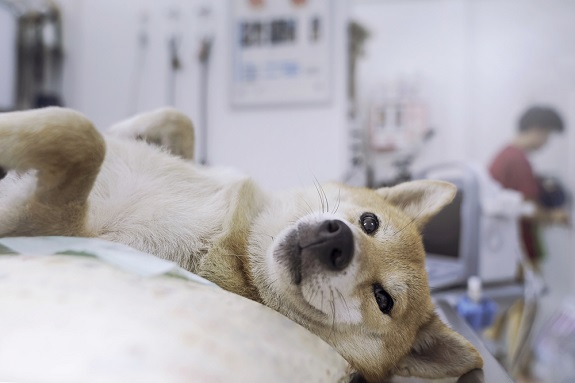
Table of Contents[Hide][Show]
Veterinary medicine offers a range of diagnostic imaging tests for dogs with mobility problems. But when your dog needs an MRI, CAT Scan, X-ray or Ultrasound, do you know what each test reveals about their spine? I was clueless.
I knew the names of the tests when my dog was referred by our vet, but I didn’t know much more. Even just learning that she needed an MRI was a little scary. I didn’t know how the test was given, the risks involved and why the MRI was the best choice over the other procedures.
If your veterinarian is recommending an imaging test for your pup, here’s clear information about each of them and the health problems they best diagnose.
MRIs are used to confirm a diagnosis that can’t be confirmed another way. – Martin Young, DVM
MRI (Magnetic Resonance Imaging)
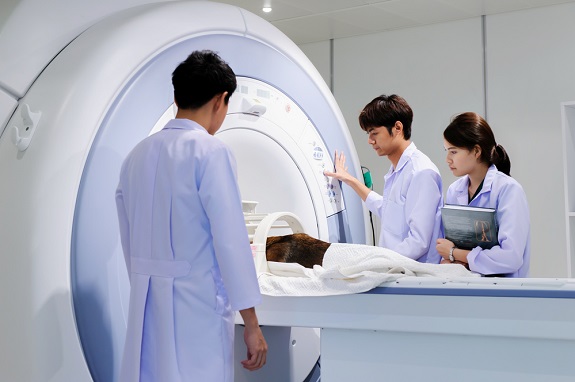
MRI’s are the newest diagnostic tool and the most expensive. They range in cost from $2,000 – $4,000. This is in part because the equipment runs as much as $1 million to buy and needs to be stored in a specially housed area to protect the rest of a veterinary hospital from its strong magnetic field.
The magnet in an MRI is up to 40,000 times as strong as the earth’s magnetic field. It can ruin nearby computers and medical equipment.
With that in mind, MRI’s are less harmful to a dog’s body than an x-ray because the scan doesn’t use radiation.
Veterinarians like to use MRIs because the images the equipment produces are the most clear and detailed. They can show abnormalities, injuries and diseases of the spine that can’t be seen with other imaging devices.
It works by magnetizing the cells of an organ while pictures are taken and sent to a computer for interpretation. Patients lie flat on a table that slides into a domed-shaped machine that looks like a small tunnel.
Patients aren’t allowed to move during an MRI so dogs must be anesthetized for the procedure. That means you won’t be able to give your dog food or water 12 hours before the scan and your dog will need time in the recovery to wake up afterwards. Dogs may continue to be groggy and not quite themselves for several hours after an MRI and should be taken directly home to relax.
MRIs are performed to determine:
- Problems with the anatomy of the spine
- Congenital deformities of the spine
- Bone, disk, ligament or spinal cord injuries after an injury
- IVDD – (Intervertebral Disc Disease), bulging or herniated disks
- Diseases in the joints of the spine, like arthritis
- Compression fractures
- Compression of the spinal cord and nerves
- Inflammation of the spinal cord or nerves
- Infection in the spine
- Tumors in the spine, nerves or the surrounding soft tissues
Click here to read more about Taking Your Dog To A Veterinary Neurologist.
CAT Scan or CT Scan (Computer Axial Tomography)
The CAT or CT scan is the second most comprehensive and expensive imaging test. It can cost $1500 – $2000.
In this test, a dog lies flat on a table that moves through a scanner. It sends x-ray beams through the body from different angles. Sensors detect the beams and send the signals to a computer that turns it into an image. As the table moves slowly through the scanner, a new picture is taken at short intervals, each one a little further back or forward from the previous one.
Because it takes time to complete a CAT Scan, dogs are anesthetized to keep them from moving.
CAT scans produce images that are white, black, and shades of gray. The different shades of gray is what helps a radiologist identify abnormal tissue.
CAT scans are especially helpful for assessing problems in the:
- Spinal cord
- Lungs
- Brain
X-rays are still a good test
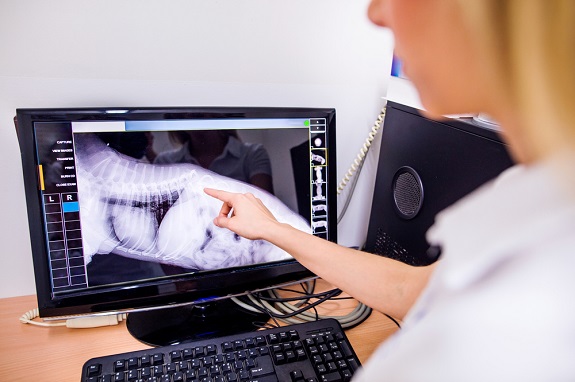
X-rays (radiographs) were the main “old-school” diagnostic tool in the past and they still give vets a lot of useful information today. An x-ray is a black and white two-dimensional image of the inside of the body.
It works by passing radiation through the body which then captures an image on film, like a photograph.
Dogs are not typically sedated for an x-ray, unless they aren’t able to lie still during the quick procedure.
X-rays are great at determining if a bone is broken or if a hard mass is present. They’re less accurate in seeing problems like the fluid from a ruptured disc in the spine.

Get the Essential Guide
The Essential Guide of Products for Handicapped Dogs e-book is a labor of love for me. I wrote it to answer your most pressing questions about where to find the best products for your wheelchair dog. You’ll find products you didn’t know existed and each will improve your dog’s quality of life. Print a copy and keep it by your side.
Ultrasound (Sonogram)
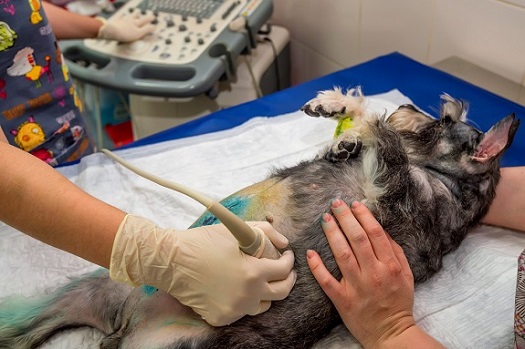
An ultrasound uses sound waves to see inside a dog’s body. A device is pressed along the outside of a suspected organ or injury as the sound waves are absorbed. It produces a live moving image that can be seen on the screen of a monitor.
Ultrasounds are relatively quick and don’t require sedation in most cases. Depending on the location of the organ being examined, a dog might have to lie in a specially designed u-shaped bed so a veterinarian can get a better look. Your dog will need to have the hair shaved from the area to be evaluated because it interferes with the images.
An ultrasound is typically done to confirm a problem, after other tests like blood work, x-rays and a physical examine have been completed.
The imaging test can see into organs and soft tissue which isn’t possible on an x-ray. It can pick up problems such as fluid in the spine and brain or diseases in an organ like the liver or heart.
On the flip side, ultrasounds are not good at seeing through air or bone and an x-ray is far better for these purposes. Many times, both tests will be scheduled for your pet.
MRI, CAT Scan, X-ray and Ultrasound – A final word
I hope this gives you a better understanding about the purpose for each of the different imaging tests, the cost involved and why one might be ordered for your dog vs. another. I also want reassure you that none of these procedures are painful.
Imaging tests are wonderful tools that give your vet information about your dog’s condition and how to proceed with their treatment. But like all tools, they aren’t miracles and they don’t cure illnesses. So, be sure to have a frank conversation with your veterinarian about your options and your dog’s overall health and age. It’ll help you make the best decision for your pet.


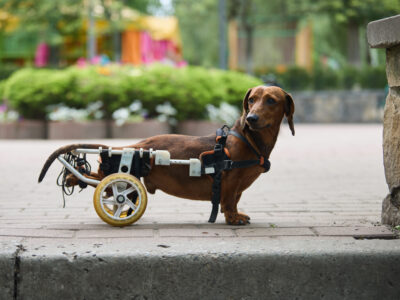


The MRI etc comparison article was exactly what we needed. Thank you for publishing it.
I’m glad the story was helpful.
Great article, thank you so much.
Did you come across any organizations or grants that can help you pay for the MRI your dog needs? My 8 yr old Chihuahua has a neck problem and we can’t resolve it until he has an MRI. I have already put in $1,000 worth of testing.
In all your research have you found any organizations that can help fund your dog’s surgery?
Thank you either way.
Eileen, Yes, there are groups that help with veterinary bills. The biggest one is Wild Hearts. Here’s a story from the website that lists all of the nonprofits that can help. https://dogwheelchairlife.com/help-when-you-cant-afford-your-dogs-vet-bill/